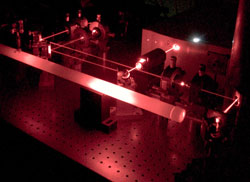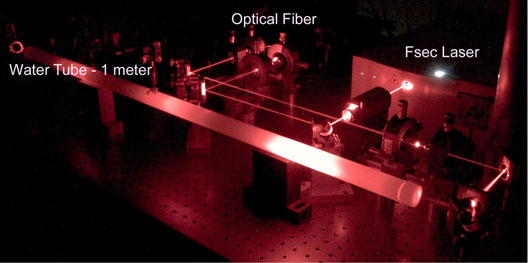Light Wave Outlasts Itself
A flash of light in water can cast off smaller flashes with surprising properties–they can travel faster and farther than the original flash. New evidence of these so-called precursors appears in the 14 May PRL. The experiment is a rare confirmation of a 90-year-old theory and the first complete demonstration of the effect using visible light. A fuller understanding of precursors could lead to advances in medical imaging and underwater communication.
If you flash a quick burst of white light in empty space, it will travel unchanged. But in a material like water or glass, the pulse will spread out as it travels, because each color within the white light moves with a different speed. If you use an ultrashort pulse of laser light instead of white light, the pulse will also break up, shedding smaller bits called precursors as it goes. Water, like most materials, has a set of exceptional frequencies at which light can travel especially cleanly, and the precursors appear at those favored frequencies. But the frequencies aren’t fixed–they change as the precursor moves through the material. An observer with superhuman vision watching a flash of light travel through water would first see a high frequency precursor galloping along at close to the speed of light. The color of that precursor would change as the observer watched. Additional precursors, with morphing colors, would follow. A bit later she would see the flash of the original light pulse.
“The precursor is like soap in the bathtub; it’s kind of slippery,” says Ulf Österberg of Dartmouth College in Hanover, New Hampshire. “It’s like it’s alive, it’s breathing, it’s moving along and changing the whole time,” in terms of the frequencies it contains. That mercurial nature makes a precursor hard to detect–only two teams have reported seeing precursors with visible light, and those were under special conditions [1,2].
The key to observing precursors is their surprising tenacity. At long distances, where the main pulse has faded into oblivion, the precursor will still be detectable because it propagates so efficiently at its “favored” frequencies. Mathematically, the main signal dies away exponentially as it is absorbed by the material, whereas the precursors only fade away with the square root of the distance from the source.
To detect a visible precursor, Österberg and his Dartmouth colleague Seung-Ho Choi sent a 100-femtosecond pulse of light into a tube of water. With such an ultrashort pulse, the laser’s color is not sharply defined, and it automatically contains all the necessary frequencies. They detected a flash in the water a meter away–a distance at which the initial pulse should have all but disappeared. The signal that they observed faded away gradually, as the square root of the distance.
“That’s the smoking gun right there, ” says Kurt Oughstun of the University of Vermont, who has been describing precursors theoretically for the past 25 years. “I was very pleased to see it. It’s a very nice result.” He is more confident that Österberg and Choi have seen a true visible precursor than he is about the two earlier experiments [1,2].
“The applications of this are far reaching, ” says Oughstun. “You can use [precursors] for communication underwater, which has obvious military applications.” They could also have medical uses. Precursors could probe deeper into the body for better imaging, such as in mammography, says Oughstun.
–Stephanie Chasteen
Stephanie Chasteen is a freelance writer and physics graduate student at the University of California at Santa Cruz.
References
- J. Aaviksoo, J. Kuhl, and K. Ploog, “Observation of optical precursors at pulse propagation in GaAs,” Phys. Rev. A, 44, 5353 (1991)
- M. Sakai,et al.,”Polariton pulse propagation at exciton resonance in CuCl: Polariton beat and optical precursor,” Phys. Rev. B, 66, 33302 (2002)
More Information
Response to this paper: Phys. Rev. Lett. 93, 269401 (2004) Another response: Phys. Rev. Lett. 94, 239401 (2005)





